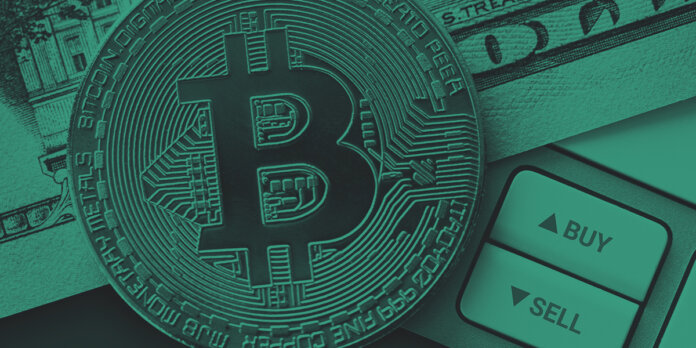Tether has traditionally been seen as an on-ramp for investors looking to acquire larger quantities of Bitcoin, but the continued increase in the market capitalization of Tether is not necessarily the result of an increase in that demand. Instead, a different phenomenon seems to be emerging: There is a demand for tether as a value in and of itself. This is due to the fact that the Stablecoin is widely used as a settlement vehicle for arbitrageurs between crypto trading exchanges.
Over the past few years, the trading exchanges for cryptoassets have become more professional, which has also made the arbitrage business more professional. Arbitrage is being conducted with ever-larger sums of money – a stable settlement currency such as the USDT seems predestined for this. Tether is also used for arbitrage purposes by individual traders. If the Bitcoin price falls, these players switch their funds into the stablecoin in order to minimize losses and buy back in at a lower price.
Having a stable currency that is denominated in dollars lets you handle your books with more ease. So, as a matter of fact, there has been a tetherification of the crypto exchange industry. With exchanges, Bitcoin has been supplanted by Tether as the base currency. Several exchanges like Binance, OKEx, or Huobi have even launched Tether-denominated futures products.
Over the last couple of months, Tether supply on exchanges has been growing significantly. It’s not only exchanges that make use of Tether’s stable characteristics, USDT is also used for arbitrage purposes by individual traders. If the Bitcoin price falls, these players switch their funds into the stablecoin Tether in order to minimize losses and buy back in at a lower price.
Figure 21: During the Last Two Years, Tether Supply on Exchanges has Grown from the Millions into the Billions.

But not only arbitrage trading between crypto exchanges but also the moving of funds between individual countries is facilitated by a stablecoin like Tether. It is well known that one of the first major uses for Bitcoin was to circumvent capital controls. The first major price increase at the end of 2013 is said to be mainly due to Chinese people moving their savings out of the country.
However, the volatility of Bitcoin has always been a thorn in the side of capital refugees. And indeed, little seems to be gained by taking your capital out of the country only to see it be eaten away by Bitcoin’s volatility during the trade.
With the launch of Tether, new opportunities for capital flight have suddenly opened up. It is therefore understandable that USDT has been discovered as a killer application. Tether is used as a cross-border crypto dollar, especially by Chinese traders and business people exporting to Russia.
Everyone Wants US Dollars
There is a reason why Chinese businessmen hold a dollar-denominated stablecoin. The US dollar is currently the global reserve, reserve and trading currency. All major commodities are settled in US dollar, which is why it now accounts for 4.7 times global imports and 3.1 times global exports. For non-US companies it therefore often makes more sense to invoice in US dollars.
But it’s not only invoices that are issued and settled in US dollars. Companies around the world have nearly 60 trillion US dollar-denominated debts. This creates an ongoing demand for US dollars to service the debts of emerging and developing countries, which will not leave their currencies unaffected. The latter currencies are likely to depreciate against the dollar, which is bound to result in increased capital controls.
The most recent example is Lebanon. Local banks there are currently in the middle of a fight against capital flight, which is why restrictions on foreign currency withdrawals, especially for US dollars, have been tightened. Tighter controls on capital movements are likely to increase not only in underdeveloped countries, but the eurozone could also become more restrictive in this regard in the foreseeable future.
In contrast to the Japanese yen and the Swiss franc, which as currencies still enjoy the character of a safe haven, demand for the euro correlates mainly with the demand for exports from the eurozone. The sooner the euro liquidity created by the European Central Bank’s ultra-expensive monetary policy exceeds international demand for the euro relative to the dollar, the faster the former will lose value. Tighter capital controls to support the euro would primarily affect European banks. They still carry large US dollar positions on their balance sheets. Without having sufficient US dollar deposits, they need to have open channels to access US dollars at all times. Tighter capital movement controls would certainly be an obstacle in that regard.
The use of crypto dollars, especially Tether, might serve as a helping and welcoming solution. Not only can potential capital controls be more easily be circumvented, but transactions using crypto dollars are generally easier to initiate and process than those using the traditional financial infrastructure.
The demand for Tether which is not an equal demand for Bitcoin should, therefore, already satisfy several real needs today. Apart from the use cases described above, particularly the increasing demand for dollars in a world of increasing capital controls will accelerate a sort of “hyper crypto dollarization.” Ironically, what we have been witnessing is the dollarization of public blockchains, which is bound to grow in next couple of years.




